Just back from my Snow Monkey and Hokkaido Photography Tour and Workshops, today I’m going to give you some initial impressions of the new Canon EOS 1D Mark IV camera, which I picked up a few days before leaving for the Snow Monkeys workshop. This isn’t going to be a thorough review, rather my impressions as a 1Ds Mark III and 5D mark II user, based on a few weeks in the field.
Also note that I’m not a sports shooter, I’m mainly a nature and wildlife photographer. If you want to read about how this camera fairs for sports photography, take a look at Rob Galbraith’s great review of the auto focus system on the 1D Mark IV [removed invalid link] after you’ve read/listened to this. 🙂
Note too that I shot on my Snow Monkeys Workshop with firmware v1.0.4 in the camera, and upgraded to firmware v1.0.6 the night before I flew to Hokkaido for that 10 day workshop. v1.0.6 supposedly improved the AF, and I personally think I noticed some improvement, though it was still a little off on a number of occasions. Let me go into some detail on this first.
When I was in Nagano shooting the snow monkeys, a number of us perched ourselves on rocks near the river to try and shoot monkeys as they jumped across the stepping stones to cross the river. I shot maybe 30 frames, as a number of monkeys jumped across the rocks, and all but one were useless. At first, I tried AI Servo focusing, and tried to lock in on the Macaque as it approached the edge of the river, and while tracking it with the auto-focus, shot a series of frames as it jumped across the river. This wasn’t working, so I tried selecting the center focus point, with focus point expansion as necessary turned on, and this didn’t really help either. Eventually, I changed my strategy and focused on the last rock before the shore, and just waited for the monkeys. With that method of focusing, I was finally able to get one shot with the monkey’s face sharp, although I clipped the top of his head.
Here’s the resulting shot, which was the only one that I got anything like what I wanted.
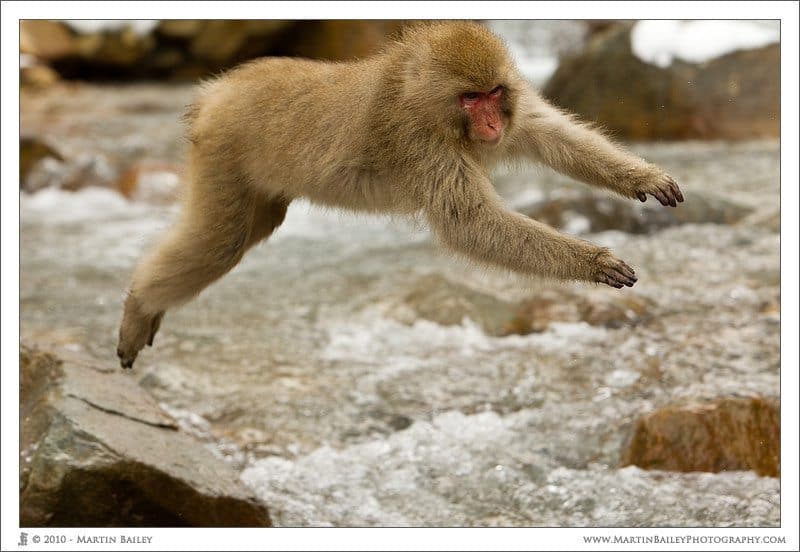
Leaping Snow Monkey
Granted though, had I not been with my workshop, I would have spent more time trying this, and I’m confident that I would have gotten something better, even by trying different AF custom settings. I shot all of my images with custom function III-4 to 1 – “Continuous AF track priority”, because I read in the manual that this works best when you have automatic expansion of focus points turned on, which I do. There’s also a new guide to setting the AF custom functions and ISO settings out (linked from this page), in which it says that option 1, the “Continous AF track priority” setting can help with fast moving subjects, and also that option 0, “Main focus point priority”, will jump to a subject closer than the one you are initially focused on, if something else moves in front of your initial subject. For the monkey shots, I think option 0 would probably have been better, because the monkey is in front of the water. The main problem when I was using the AF in AI Servo mode is that the water kept grabbing the auto-focus, even though I started off tracking the monkey.
After my Hokkaido trip about 12 days after the Snow Monkey workshop, Rob Galbraith released a great review of the auto focus system on the 1D Mark IV in which I noticed that Rob leaves Custom Function III-4 set to 0, which is “Main focus point priority”. I imagine this is better for sports, and I will at least try option 0, “Main focus point priority”, but quite often, I want to stay locked on my subject, even if something moves in front of them.
Although my experience with the higher contrast water stealing focus from the jumping monkeys had me a little unhappy with the autofocus’ “intelligence”, I have to say that when I was in Hokkaido, now with the firmware upgraded to v1.0.6, I was much more happy with the ability of the auto-focus in AI Servo mode to stick with the subject, once I was locked in to it. In the below image (not a great shot, I know), I purposefully lowered the camera while tracking a group of Whooper Swans flying out of the Akan International Crane Center, to see if the AI Servo would continue to lock on and track them. It did a great job of this.

Swans Flying Away
I was also impressed with the ability of the focus to lock-on to a subject such as sparrows in a narrow strip on the snow, and then track them accurately as they took flight, as in the below photograph.
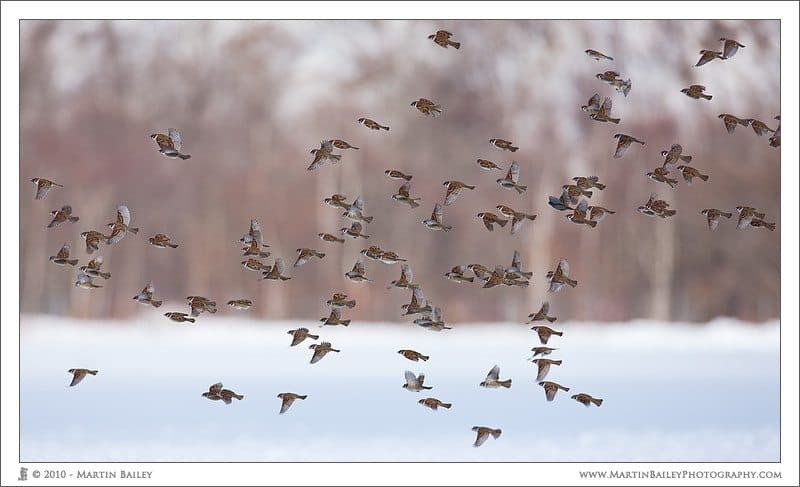
Sparrow Flight
These guys are relatively predictable, but very fast as they take flight, and the AI Servo focusing on the 1D Mark IV did a great job of sticking with them, even as I moved away from my original point of focus, when the birds were in the snow looking for left-over seeds. This is something that has had my 1Ds Mark III’s focus system searching in the past.
NOTE/APOLOGY — I realized after producing this episode that the above image of the sparrows was shot with my 1Ds Mark III, and not the 1D Mark IV. I guess the 1Ds Mark III auto-focus either got better, or I got better at this sort of shot, but either way, it did handle this much better this year, despite that not being the case in previous years. Sorry about the incorrect information given here.
The new AI Servo Custom Function Guide here, says that if you track a subject with AI Servo for 0.5 seconds before you start to make exposures, the accuracy of the auto-focus increases. I think this might have also been part of my problem with the monkeys jumping shots. Most of the time, I would see the monkey at the last minute, and try to snatch focus as they got to the first stepping stone. In Hokkaido, again with the new firmware mind, once I locked into something, the AI Servo stayed locked in most of the time. Tracking a bird flying around in the sky was very easy, although my 1Ds Mark III also does a pretty good job of this, because there’s little else in the frame to cause problems.
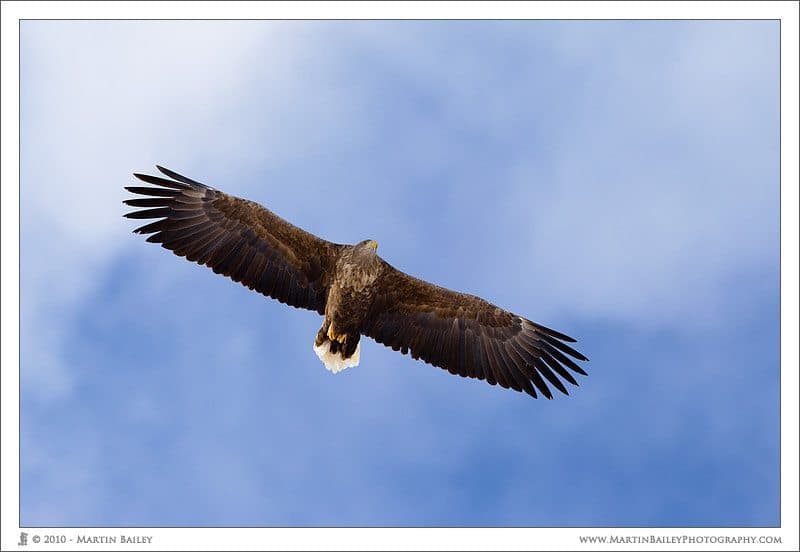
Soaring White Tailed Eagle
Even as the eagles dived down and went through a crowd of red-crowned cranes, to steal their fish, the AI Servo stuck with the eagles. There were so many cranes this year that I didn’t get a clear shot of the eagles within the cranes, but I was very impressed with the ability of the 1D Mark IV to track the subject in this situation. Again, this was probably because I had custom function III – 4, set to 1 – “Continuous AF track priority”.
Other times that the auto-focus was unfaltering, was when the subject flew in front of the sun. This has typically been a little difficult, sometimes causing my 1Ds Mark III and 5D Mark II to start searching for focus, but it happened very rarely with the 1D Mark IV. In the below image, we can see three cranes passing right in front of the sun, and the auto-focus handled it without issues.
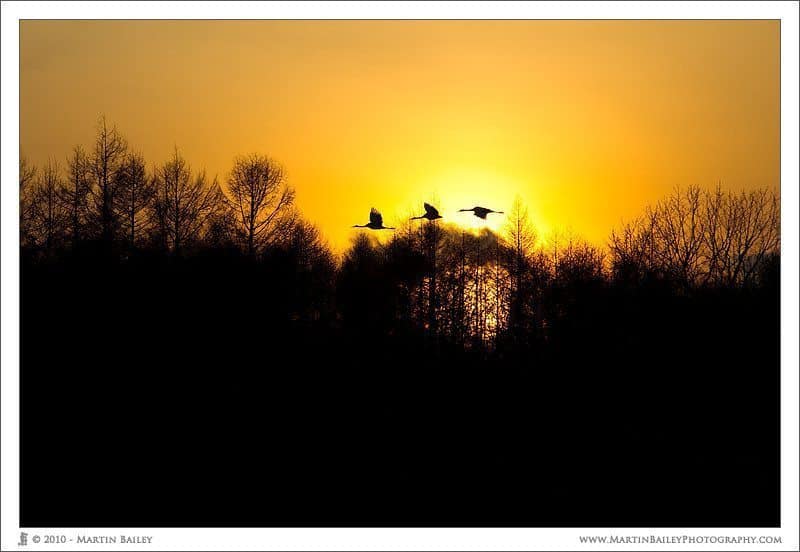
Cranes at Sunset
Crop Factor
This is the first crop factor camera that I’ve owned in over four years, since I bought my 5D, and sold my 20D. The Canon EOS 1D Mark IV has an APS-H sensor, which results in a 1.3X crop factor. This isn’t as large as the 1.6X crop factor that my old 20D which had, but it still took a little getting used to again. A number of times I found myself reaching for the 300mm f2.8 and having to drop down to the 70-200mm F2.8 lens, because the 300/2.8 was a little too long, with a 390mm effective focal length. Once I got used to it though, I did like the additional reach that the 1.3X crop factor gives me, and most of the time for eagles etc. I just used the 300mm F2.8 L lens without the 1.4X Extender (Teleconverter) which gives me 420mm with the 300/2.8 on a full frame sensor camera like the 1Ds Mark III or 5D Mark II. I also enjoyed getting an effective focal length of 780mm from the 600mm F4 L lens too, when shooting down the river from the Otowa Bridge in the town of Tsurui, for shots of the red-crowned cranes in the mist, like below. Unfortunately, there was no frost of the trees this year, but still, a little mist rose from the river as the sun started to warm the surface of the water.
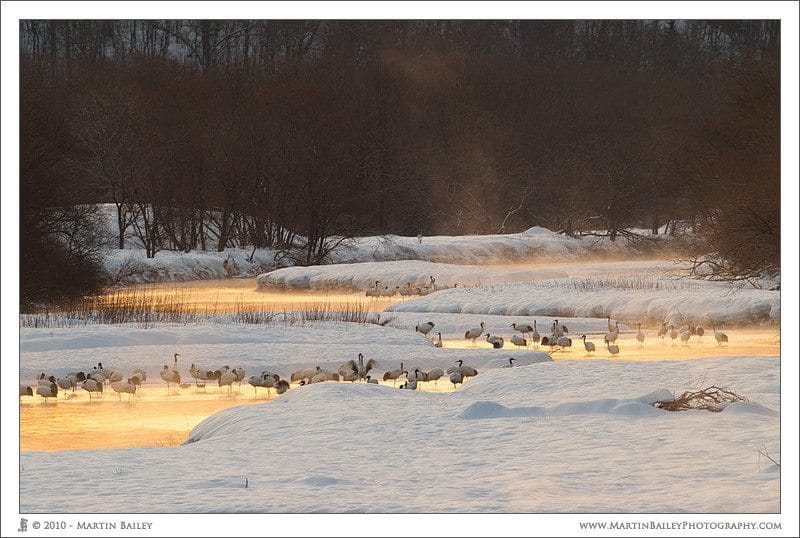
Crane’s Roost at Dawn
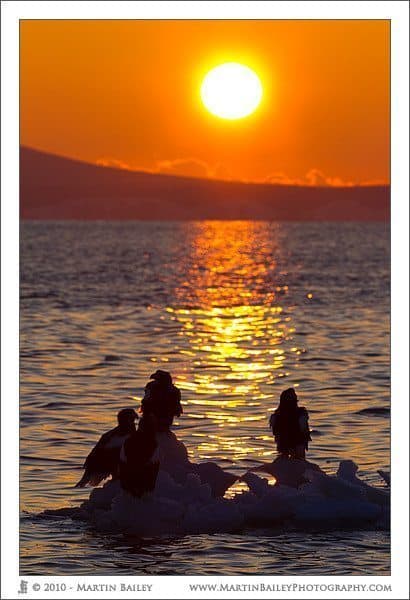
Eagles at Sunrise over Russia
One situation where I did have a slightly lower hit rate with the auto-focus, was when shooting some eagles on a piece of stray ice floe (left). Here, a few of the shots jumped back to the sunlit ripples on the sea, because they were higher contrast than the almost totally silhouetted Steller’s Sea Eagles. This may well have been caused by a focusing error on my part though, as it was difficult to see through the viewfinder looking into the morning sun with an effective focal length of 390mm.
I don’t mean to harp on about the auto-focus, but because Canon seemed to make this a focus of their marketing for the 1D Mark IV, I was expecting quite a lot of the new system. I bought my 1Ds Mark III just over two years ago, with high hopes that the 45 focus points and a few more years of R&D were going to provide me with a usable AI Servo focusing system that would be able to handle more than just birds flying across a clear sky. It turned out though that I always ended up going back to the center focus point, and quite often even returning to One Shot focusing as opposed to AI Servo for pretty much all other situations.
When I bought the 5D Mark II, I actually didn’t find the 9 focus point system much worse than the 45 point 1Ds3 system, because of the way I ended up always using my 1Ds Mark III. The 5D2 tracks birds across a clear sky about as good as the 1Ds Mark III does too.
Overall Very Happy
Once I upgraded to the 1.0.6 firmware, I really didn’t have much to complain about with the 1D Mark IV auto-focus. I do have some flying eagle shots that are not quite as sharp as I’d like them to be, even with nice fast shutter speeds, but I also have many incredibly sharp shots too, so I really need to shoot a little more with this camera and maybe do some controlled tests, before I start to shout about problems with the camera and/or its auto-focus. Right now, in general, I’m feeling pretty happy with the camera.
Drop in Image Size
The slight drop in resolution to 16 mega-pixels from 21MP in the 1Ds3 and 5D2 is noticable. Although the image quality from the 1D Mark IV is excellent, when you want to zoom in to really see the detail, it’s a little bit disappointing. This is something that I expected of course. The images are roughly 76% the size of my full frame sensor cameras. Is this going to be a problem for me? I doubt it. I do like the detail I can get in large prints, but 16MP is still a very respectable image size. I’m looking forward to printing out some of my new images on fine art paper, to really see how they fair, but I’m not expecting to be disappointed.
High ISO Capabilities
The 1D Mark IV has standard selectable ISOs from 100 to 12,800, and these are expandable downwards to ISO 50, and upwards to include ISOs 25,600, 51,200 and 102,400! I haven’t had time to do any really controlled tests yet, but from some quick shots in my living room, which was very messy with the contents of the 1D Mark IV box emptied out, and therefore I can’t get permission to use the shots here to illustrate this, I can tell you that 25,600 and 51,200 is very usable. At a pinch, if it was a toss-up between getting a shot, and not getting anything, I’d even go to ISO 102,400, but the noise is pretty bad at this highest ISO. The first two though really are acceptable and would probably clean up pretty nicely with some noise reduction work. They aren’t bad straight out of the camera!
Other Nice Touches
There are a few other nice touches that have been added to the Canon EOS 1D Mark IV that I would like to touch on before we finish.
Focus Point Auto-Selection by Orientation
Firstly, the 1D Mark IV allows you to set a preset focus point per camera orientation, with the Custom Function III – 16, “Select different AF points” selected. With this on, you can preselect a focus point for three different orientations, and the camera will automatically switch to those focus points as you change the camera orientation. So you can have one focus point selected when using the camera horizontally, or in landscape mode, and have another focus point automatically selected when you rotate it to the left, with the grip at the top, and then another focus point selected when you rotate the camera to the right, with the grip at the bottom.
Spot AF
Another nice addition is Spot AF, which is selected as on option under Custom Function III-6. This allows you to reduce the size of the focus point to enable more accurate selection of the subjects eyes etc. The only problem with this for me at the moment is that I already map my AF Stop button to another function. The AF Stop buttons are the little rubberized buttons near the front of Canon’s super-telephoto lenses, such as the 300mm F2.8 and the 600mm F4 lenses, and I already map this button to toggle between One Shot and AI Servo focusing modes. I did find myself using this button much less with the new improved focusing capabilities of the 1D4, so if I continue to be happy with the focusing, I might be able to map my AF Stop button to the Spot AF feature in the future instead.
Illuminated Focus Points in AI Servo Mode
You can now also see which focus point is being used in the AI Servo focusing mode. This is something that I hated about my 1Ds Mark III, and one of the reasons why I found AI Servo so difficult to use, especially in conditions such as when photographing a bird on water, when the camera would almost always focus on the higher contrast light on the ripples in the water, without me knowing. Note that this illuminated focus point functionality only works when you have manually selected a focus point, and then started to track your subject. As they move across the frame, or you reposition the camera, the focus point moves too, and is illuminated as it does so, to enable you to ensure that you are still focusing on the right part of the subject. I’m really looking forward to trying this in portraiture as well. If I can focus on the eye with the center or manually selected focus point, then the camera continues to track the eye as I recompose, and then focus on it with AI Servo focusing, that would be impressive, not to mention incredibly useful.
High Resolution LCD
One thing that really bugs me about my 1Ds Mark III is the crappy LCD resolution. Granted, since getting my first chance to use LiveView with the 1Ds3, I started to use it to fine tune focusing for still-life and landscape work pretty quickly. When 230,000 dots is all you have, you can certainly use it, but it was far from clear. You basically could tell that you had achieved optimal focus only as you went past it. If the image on the LCD starts to get soft again, you know you’ve gone too far, and you pull back a little. The 5D Mark II though came with a nice sharp 920,000 dot LCD, and that changed the game for me. Now I was able to adjust and confirm sharp focus on the LCD so much faster in LiveView, and the 1D Mark IV has the same resolution. 920,000 glorious dots to help us see what we’ve shot incredible clearly. This is not just useful in LiveView of course. When you check an image that you have already shot for sharpness by zooming in on the LCD, you also benefit from having four times more resolution.
Video
You can’t ignore the fact that this is the first pro-body from Canon with video. The 1Ds Mark III does not have video, and the fact that the 5D Mark II did meant that it soon became my camera of choice over the 1Ds Mark III, when ruggedness and weatherproofing was not going to be important. I do love being able to stick an L lens on my 1 series bodies, and just stand out in the rain with them without having to worry about and mollycoddle my gear, and this is certainly one other reason why I have invested in the 1D Mark IV as well, my second pro body, but video and the much higher resolution LCD on the 5D meant that it’s seen much more use over the last year than my 1Ds Mark III, which is a shame, when you think that it cost me four times more to buy the 1Ds3. 🙁
I haven’t touched on the 1D Mark IV’s video capabilities today though, because I haven’t use it in the field yet. I did shoot some video in Hokkaido over the last few weeks, but it was with the 5D Mark II. When I’ve had a chance to play with the video on the 1D Mark IV, I’ll let you know.
Conclusion
As I said above, I’m generally very happy with my new Canon EOS 1D Mark IV camera. It’s living up to my expectations and then some. I’ll be even happier when I see more totally crisp, sharp shots coming out of it, but I still had a very high percentage of sharp images from my first few weeks, so I’m happy enough for now. I’ll be sure to shout up if this ceases to be the case in the coming weeks, so stay tuned!
Podcast show-notes:
Rob Galbraith’s review of the Canon EOS 1D Mark IV from a sports shooters perspective is here: [Removed invalid link]
I’m not sure why I can’t find this on the Canon Web site, but here is a link to that AI Servo Custom Function Guide: http://lightingmods.blogspot.com/2010/02/exclusive-canon-eos-1dmarkiv-custom.html
Audio
Download the Enhanced Podcast M4A files directly.

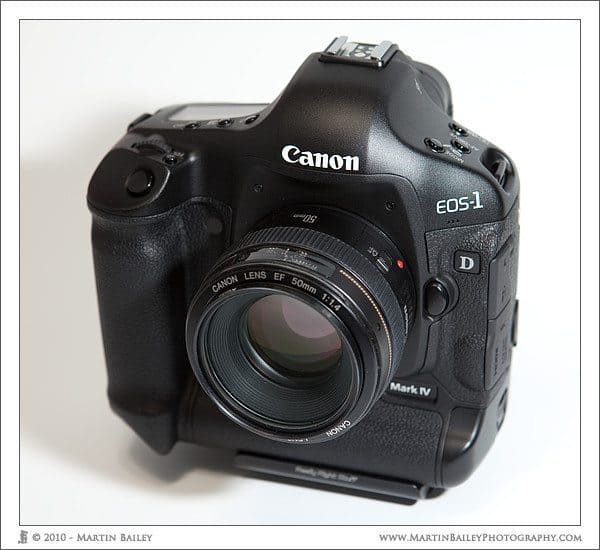

0 Comments